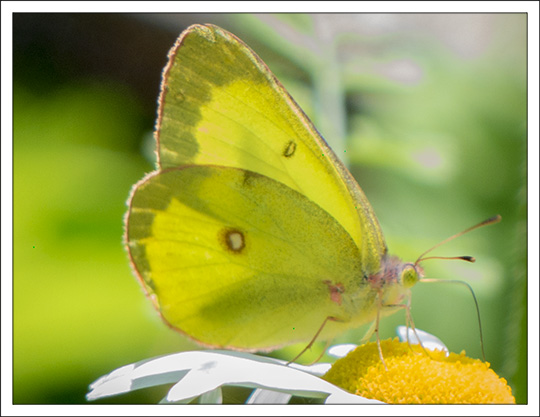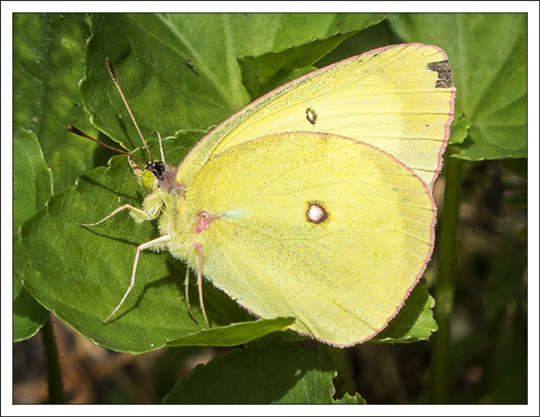Butterflies of the Adirondack Mountains:
Pink-edged Sulphur (Colias interior)
 Butterflies of the Adirondacks: Pink-edged Sulphur in the Paul Smiths VIC Butterfly House (6 July 2013)
Butterflies of the Adirondacks: Pink-edged Sulphur in the Paul Smiths VIC Butterfly House (6 July 2013)
| This page is no longer being updated. For an updated version of this material, see: Pink-edged Sulphur (Colias interior). |
Identification: The Pink-edged Sulphur (Colias interior) is a medium-sized yellow butterfly that may be seen in the Adirondack Mountains of upstate New York in June and July. It is a member of the Pieridae family. [1] [2] The wings are rounded. [3] Both males and females have conspicuous pink wing edges. [4] [5] [6] The upper side is bright yellow with a black border. [7] [8] However, this butterfly normally rests with its wings closed, so the upper side is rarely seen. The underside of the hind wing is a clear yellow with a single silver cell spot circled in pink. [9] [10] It has no postmedian spots. [11] The wing span 1 1/2 to 2 5/8 inches.
The Pink-edged Sulphur is easily confused with the very similar Clouded Sulphur and the Orange Sulphur, both of which are also seen in our part of the Adirondacks.
- The Clouded Sulphur normally has dark spots on the underside of the hind wing. [12] [13] In addition, the center spot on the underside of the hind wing is usually double. [14]
- The Orange Sulphur also has a series of dark spots on the underside of both wings. However, there is normally an orange patch on the fore wing, which distinguishes it from the Clouded Sulphur.
- The Pink-edged Sulphur has conspicuous pink wing edges and lacks the dark spots on the underside of the wings.[15] [16] The center spot on the hind wing is single, rather than double. [17] [18] [19] [20]
Life History: Males patrol with a slow flight for females. [21] The female Pink-edged Sulphur lays her eggs in midsummer on blueberry leaves. [22] [23] The eggs are white, turning orange or greenish yellow soon after being laid. [24] [25] The larva is yellow-green with light stripes on the back and a white lateral stripe with a red link through it. [26] [27] The young caterpillars hibernate and overwinter. [28] [29] Most feeding occurs the following spring. [30] [31] Caterpillar hosts include various blueberry plants in the heath family. [32] [33] [34] The adults sip flower nectar and mud. [35] [36]
 Butterflies of the Adirondacks: Pink-edged Sulphur in the Paul Smiths VIC Butterfly House (12 July 2013)
Butterflies of the Adirondacks: Pink-edged Sulphur in the Paul Smiths VIC Butterfly House (12 July 2013)
Habitat and Range: Pink-edged Sulphurs make their homes in shrubby openings in woods, bogs, meadow edges, forest openings, or scrub areas where plants of the heath family grow. [37] [38] [39] This butterfly may often be found in recovering burns or logged sites. [40] The Pink-edged Sulphur is a boreal zone species which occurs in Canada and the northern parts of the US. [41] [42] The range of this butterfly is much more limited than that of the Clouded Sulphur. [43] It may be found from British Columbia and eastern Oregon east through the Great Lakes area to northern New England and the Adirondack Mountains. [44] [45] [46]
Flight: The flight period for Pink-fringed Sulphurs throughout its range is from late May into early September, [47] [48] peaking in early July to early August. [49] There is only one brood. [50] [51] [52] [53] This butterfly's flight period in the Adirondack Park has not been established. It is, however, a fairly frequent guest in the Paul Smiths VIC Native Species Butterfly House. in 2012, The Pink-edged Sulphur was recorded as present from the day of the Butterfly House opening (9 June) to 25 July. [54] In 2013, Pink-edged Sulphurs were present in the Butterfly House during the month of July. [55]
References
- Susan Grimm Hanley. Interpretive Naturalist, Paul Smith's College Native Species Butterfly House. Species Logbooks.
- Butterflies and Moths of North American. Species Profiles. Confirmed sightings: 7/6/13, 7/12/13, 7/12/13
- Government of Canada. Canadian Biodiversity Information Facility. SpeciesBank
- ENature. Field Guides.
- Iowa State University. Department of Entomology. BugGuide.
- University of Alberta. Department of Biological Sciences. E.H. Strickland Entomological Museum. Colias interior.
- Ross A. Layberry, Peter W. Hall, and J. Donald Lafontaine. The Butterflies of Canada (University of Toronto Press, 1998), pp. 113, Plate 9.
- National Audubon Society. Field Guide to Butterflies (New York: Alfred A. Knopf, 1981), pp. 380-381.
- Jim P. Brock and Kenn Kaufman. Kaufman Field Guide to Butterflies of North America (Houghton Mifflin, 2003), pp.62-63.
- Paul A. Opler. A Field Guide to Eastern Butterflies (The Peterson Field Guide Series, Houghton Mifflin Company, 1992,1998), pp. 60-61, 159.
- James A. Scott. The Butterflies of North America. A Natural History and Field Guide (Stanford University Press, 1986), pp. 199-200.
- Jeffrey Glassberg. Butterflies through Binoculars. The East. A Field Guide to the Butterflies of Eastern North America (Oxford University Press, 1999), p. 104, Plate 28.
- Paul A. Opler and George O. Krizek. Butterflies East of the Great Plains: An Illustrated Natural History (The Johns Hopkins University Press, 1984), p. 67, Plate 8.
- Jeffrey Glassberg. Butterflies through Binoculars. A Field Guide to the Butterflies in the Boston-New York-Washington Region (Oxford University Press, 1993), p. 30, Plate 40.
